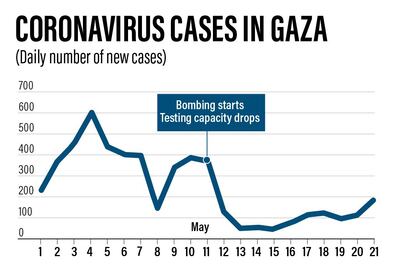As the smoke over the Gaza Strip clears after 11 days of Israeli bombardment, fears are growing of a surge in coronavirus cases.
More than 100,000 people displaced from their homes by Israeli air strikes sought shelter from further bombardments huddled together in makeshift shelters and overcrowded family homes – ideal environments for the spread of Covid-19.
While the extent of damage to the besieged enclave's buildings and infrastructure has become clearer since Friday's ceasefire, the true spread of the virus is more difficult to establish.
Operations at the enclave's only sample testing laboratory are only just picking up again after a nearby missile strike brought its water and power supply to a four-day halt.
Six hospitals and 11 medical facilities – including Al Rimal clinic where Covid-19 vaccinations were being administered – have been damaged or its services were impacted by the bombardments.
Israeli air strikes killed 248 people, including 66 children, and wounded 1,948, according to the Gaza Health Ministry.
"We have gone from conducting 4,000 coronavirus tests a day to around 1,500," Dr Adel Al Roga, the head of Gaza's only coronavirus testing laboratory, told The National.
“The facility is unsuited for receiving people and patients who wish to get vaccinated," he said.
This was even after technical teams brought power and water back to the clinic.
The World Health Organisation's most recent Covid-19 situation report was on May 6 – a day before protests in Al Aqsa Mosque compound against evictions in East Jerusalem's Sheikh Jarrah neighbourhood began.
It listed Gaza as the main contributor to the total number of Covid-19 cases in the occupied Palestinian territories.
While an Egypt-brokered ceasefire has halted the conflict between Israel and the Hamas militant movement that controls Gaza, much remains to be done to rebuild Gaza's shattered infrastructure.
“Destruction to main roads and highways connecting governorates has hindered the ability to reach people and take samples for testing, preventing us from having an accurate impression of the virus’s true spread,” Dr Al Roga said.
Almost half of Gaza’s intensive care units were occupied by Covid-19 patients before the air raids began, according to the WHO.
With almost 2,000 people wounded in the bombardment, those medical facilities are now likely to be pushed to their limit.











